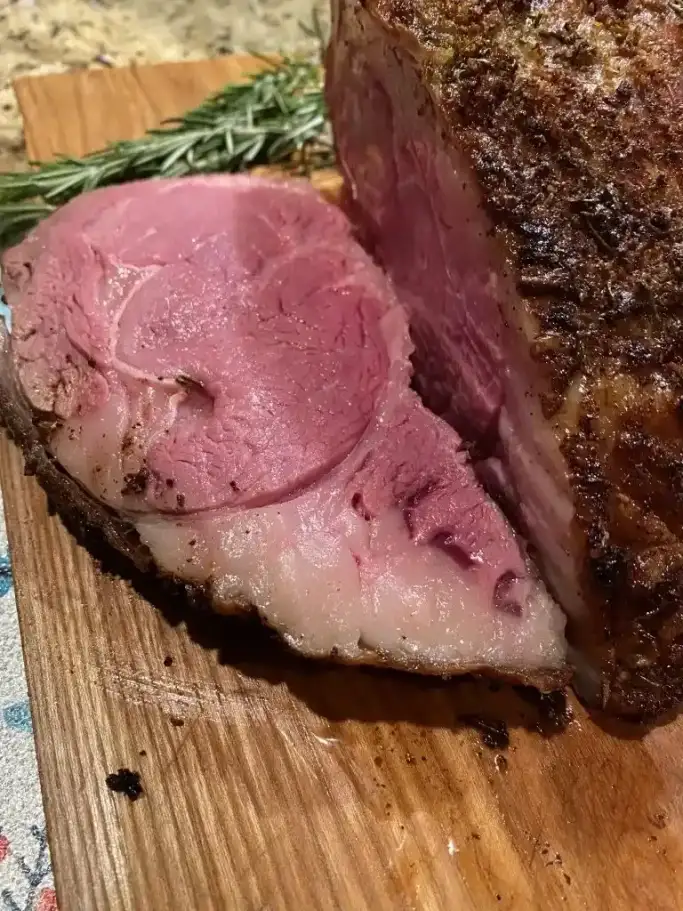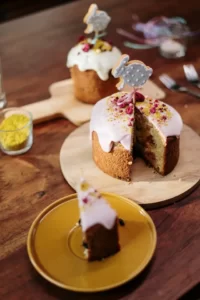Prime rib is the crown jewel of any feast. It’s the kind of dish that immediately sets the tone for an unforgettable meal, with its juicy, tender meat and rich flavors.
If you’ve ever wondered what makes prime rib so special, it’s all about balance—crispy, golden edges, a melt-in-your-mouth center, and the perfect seasoning to bring out all the natural goodness of the meat.
But here’s the thing: it’s not just about throwing a piece of meat in the oven and hoping for the best.
The magic happens when you know exactly how to season, cook, and rest it. Prime rib isn’t a dish you rush; it’s one that demands attention, patience, and a little bit of love.
When done right, it’ll be the star of any gathering, leaving everyone at the table asking for seconds.
So, if you’re ready to treat your taste buds to something extraordinary, keep reading. This is the ultimate guide to cooking the perfect prime rib.
Table of Contents
TogglePerfect Prime Rib Recipe
Ingredients
- 4 lb rib roast (choose prime or choice)
- 1 to 2 sticks of butter (softened)
- 1 tbsp minced rosemary
- 1 tbsp garlic powder
- 1 tbsp onion powder
- 1 tbsp black pepper
- Coarse or Kosher salt (use about 2 teaspoons in the butter mixture, plus more for seasoning)
Instructions
- Begin by softening the butter. Add minced rosemary, garlic powder, onion powder, black pepper, and salt. Mix well by hand or with a hand mixer until smooth.
- Rib roasts come in two main types: prime and choice. While prime rib is usually more expensive, choice rib roasts are often more affordable and still very delicious. The roast will be attached to a bone, and it’s often wrapped in netting to hold the meat in place during cooking. Keep the netting on while cooking—it helps the roast stay in shape and cook evenly.
- Take the rib roast out of the fridge and let it sit for about 30 minutes to an hour so it reaches room temperature. Pat it dry with a paper towel to remove any excess moisture.
- Generously season the roast on all sides with salt and black pepper. Then, spread the herb butter mixture evenly over the top and sides of the roast. You can use a rubber spatula to make sure it’s well-coated.
- Use a roasting pan that is just slightly larger than your roast. This helps to keep the juices in and makes a great base for the au jus. If you have a small rack, place it in the pan, but if you don’t, don’t worry—the roast will cook fine without it.
- Heat your oven to its highest setting, ideally 550°F (290°C). Place your rib roast uncovered in the oven. Cook it at this high temperature for 20 minutes. Do not open the oven door during this time. The heat needs to stay inside to give the roast a nice sear.
- After 20 minutes, turn the oven temperature down to 150°F (65°C) for a rare roast, or 250°F (120°C) for a medium roast. Cook the roast for about 30 minutes per pound. For example, a 4 lb roast would cook for about 2 hours. Tip: The roast will continue cooking as it rests, so if you prefer rare, aim for an internal temperature of 125°F (52°C). For medium, cook it to around 135°F (57°C).
- After cooking, turn off the oven and let the roast rest in the oven for 40 minutes—do not open the door. This helps the meat continue cooking gently with the residual heat. After 40 minutes, take the roast out and cover it loosely with foil. Let it rest for an additional 20 minutes on the counter.
- Before slicing, check the internal temperature of the roast. For rare, it should be about 125°F (52°C). If you like your slices more done, you can return them to the oven for a few minutes at 350°F (175°C) to cook to your liking.
- While the roast is resting, use the drippings from the pan to make a flavorful au jus. Add the drippings to a saucepan and mix with halal-certified beef broth (or vegetable broth for a lighter version). Thicken the jus with a little cornstarch slurry (mix a tablespoon of cornstarch with cold water and stir into the broth).
- Carefully remove the netting from the roast, taking care not to pull off the crispy outer crust. The roast will still be attached to the bone, so cut it away from the bone. Save the bone for making a hearty soup later! Slice the meat into thick pieces, or thinner if you prefer.
- For a tangy kick, whip up some horseradish sauce. Simply add 1 cup of heavy cream to a bowl and whip it until light and fluffy. Stir in as much horseradish as you like, and finish with a sprinkle of chopped chives.

How To Choose The Best Prime Rib?
Choosing the right prime rib is essential for a delicious meal. Here are some important things to consider when shopping for your prime rib:
- Look for Marbling: Marbling refers to the fat streaks inside the meat. The more marbling, the juicier and more flavorful the meat will be. When you look at the prime rib, choose one with visible fat marbling throughout.
- Choose Between Prime or Choice: Prime is the highest quality of beef, offering excellent tenderness and flavor, but it’s more expensive. Choice is a great alternative that is still tender and tasty but usually more affordable. Either is a good option depending on your budget.
- Bone-In or Boneless: Bone-in prime rib has more flavor because the bone helps keep the meat juicy and tender while cooking. Boneless prime rib is easier to carve and can be more convenient for large gatherings.
- Check the Color: The meat should be a rich red color, with a little bit of white fat. If the meat looks brown or overly pale, it might not be fresh or well-marbled.
- Consider the Size: A 4- to 7-pound roast is perfect for most gatherings, serving around 6-8 people. If you need a larger roast, make sure your oven is large enough to handle it.
- Ask Your Butcher for Advice: If you’re unsure about which prime rib to pick, ask the butcher for recommendations. They can guide you based on your needs and what’s available.
Helpful Tips For Cooking Prime Rib
Prime rib is a showstopper when cooked right. Here are some simple yet effective tips to help you achieve the perfect roast every time:
- Order from Your Butcher: When buying your prime rib, ask your butcher to “cut the ribs away and tie them back.” This will make the roast easier to cook evenly and carve, as well as eliminate the need for a roasting rack. The butcher will also trim off any excess fat and tie the roast neatly for you.
- Consider Serving Size: The size of your prime rib depends on how many people you’re serving. A good rule of thumb is one bone per two people or about 1 pound of bone-in meat per person. If you’re not sure, ask your butcher for advice based on your guest list.
- Rest the Roast: After the roast comes out of the oven, don’t skip the resting time! Let the prime rib sit for about 30 minutes. This allows the juices to redistribute, making the meat even juicier and more tender. You can use this time to prepare sides or greet your guests.
- Easy Carving: If you’ve had your butcher trim and tie the roast, carving will be much easier. After removing the twine, you can slice through the roast with ease. For bone-in prime rib, using an electric carving knife can help achieve clean, even slices.
- Monitor the Temperature: Use a meat thermometer to check the internal temperature of the prime rib. For rare, aim for 125°F (52°C), and for medium, go for 135°F (57°C). This ensures you get the perfect doneness without overcooking the meat.
- Don’t Overcrowd the Oven: Make sure there’s enough space around the prime rib in the oven for hot air to circulate. If your oven is crowded, the roast may not cook evenly.
What To Serve With Prime Rib?
When it comes to pairing sides with prime rib, the goal is to complement its rich, savory flavor. Here are some great options to serve alongside your prime rib:
- Mashed potatoes
- Roasted vegetables
- Garlic bread
- Green beans almondine
- Caesar salad
- Yorkshire pudding
- Gravy or au jus
- Creamed spinach
- Baked sweet potatoes
- Mac and cheese
How To Store Leftover Prime Rib?
Leftovers from a prime rib dinner can be just as enjoyable the next day if stored properly. Here’s how to keep your prime rib fresh:
- Refrigerate: Place leftover prime rib in an airtight container or tightly wrap it in plastic wrap or foil. Store it in the fridge for up to 3-4 days.
- Freeze: For longer storage, wrap the prime rib tightly in plastic wrap or foil, then place it in a freezer-safe bag or container. It can be frozen for up to 3 months.
- Reheat Properly: When reheating, use a low oven temperature (about 250°F or 120°C) to warm the meat without drying it out. You can also slice it and heat it in a pan with a little broth or butter for extra moisture.
The Best Sauces To Serve With Prime Rib
Prime rib is delicious on its own, but a great sauce can take it to the next level. Here are some of the best sauces to pair with your prime rib:
- Au Jus: This is the classic sauce for prime rib. It’s made from the juices that drip from the roast while it cooks, seasoned with beef broth, garlic, and herbs. It’s rich, savory, and perfect for dipping or drizzling over your meat.
- Horseradish Sauce: A tangy and spicy sauce that perfectly complements the richness of prime rib. It’s made with horseradish, sour cream, and a little vinegar or lemon juice. It adds a zesty kick that balances the meat’s flavor.
- Garlic Butter: For a rich and buttery option, garlic butter is a fantastic choice. Simply melt butter with minced garlic, parsley, and a touch of lemon juice. The buttery texture enhances the beef without overpowering it.
- Creamy Mushroom Sauce: For a creamy twist, a mushroom sauce made with cream, garlic, and fresh herbs is perfect. The earthy mushrooms complement the beef, and the creaminess adds a smooth texture.
- Chimichurri Sauce: If you like a fresh, herbaceous touch, chimichurri sauce is a great choice. Made with parsley, cilantro, garlic, vinegar, and olive oil, it adds a fresh and slightly tangy flavor that brightens the richness of the meat.

Prime Rib Temperature Guide
Cooking prime rib to the perfect temperature is key to achieving the desired level of doneness. Here’s a simple temperature guide to help you cook your prime rib just the way you like it:
- Rare: 120-125°F (49-52°C)
A rare prime rib will have a cool, red center with a slightly warm outer edge. This is perfect for those who enjoy tender, juicy meat with a deep red color inside.
- Medium-Rare: 130-135°F (54-57°C)
This is the most popular doneness for prime rib. It will have a warm, pink center with a rich, juicy texture. The outer layer will be browned, while the inside remains tender and pink.
- Medium: 140-145°F (60-63°C)
A medium prime rib will have a slightly pink center, but the meat is firmer than medium-rare. The outer layer is well-browned, and it’s still juicy but with less redness in the middle.
- Medium-Well: 150-155°F (66-68°C)
Medium-well prime rib has a slight pink center but is mostly brown throughout. The meat is firmer and less juicy, and it’s suitable for those who prefer less redness in their steak.
- Well-Done: 160°F (71°C) and above
A well-done prime rib will have no pink inside. The meat will be fully cooked through, but it may lose some tenderness and juiciness.
How Much Prime Rib To Serve Per Person?
When planning a meal with prime rib, knowing how much to serve per person ensures that everyone gets enough to enjoy without wasting any. Here’s a simple guide to help you determine the right amount:
- Bone-In Prime Rib: If you’re serving bone-in prime rib, plan for about 1 rib bone for every 2 people. This means each person will get a portion of meat attached to one bone, which is typically about 1 pound per person.
- Boneless Prime Rib: For boneless prime rib, you can estimate around 1/2 to 3/4 pound of meat per person. Since there’s no bone, you’ll need slightly less to account for the lack of weight from the bone.
- Consider Appetite and Leftovers: If you’re serving big eaters or want to make sure there are leftovers, consider increasing the portion size to about 1 pound per person, especially if the roast is boneless. For smaller appetites, you can reduce the portion to about 1/2 pound per person.
- Planning for Leftovers: If you love leftovers, aim for 1 pound per person. Prime rib keeps well and can be enjoyed the next day in sandwiches, salads, or other dishes.











